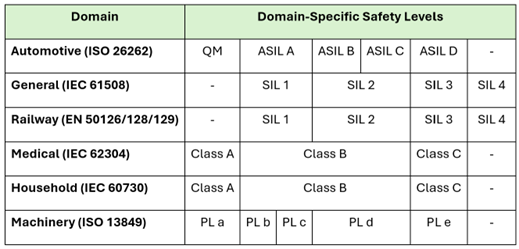Product Testing and Certification
13. December 2024
Back to all news
Comparative Overview of Safety Standards Across Domains
Standards for safety-critical systems often define specific safety levels that, while differing in terminology and implementation, share the common goal of quantifying risk and defining safety requirements. The key distinctions lie in how these frameworks approach safety, as outlined below:
- SIL (Safety Integrity Level) and ASIL (Automotive Safety Integrity Level) focus on probabilistic targets. ASIL, specific to the automotive domain, further incorporates factors like controllability and exposure unique to vehicle systems.
- Classes (IEC 60730) provide a simpler framework tailored to appliances, emphasising operational diagnostics rather than detailed probabilistic analysis.
- PL (Performance Level, ISO 13849) adopts a hybrid approach, combining qualitative and quantitative methods specifically for machinery safety.
- Railway standards extend the SIL concept, incorporating additional application-specific metrics to address the unique challenges of rail systems.
These frameworks reflect the varying complexities of their respective domains, from household appliances to high-risk applications in automotive, industrial machinery, and railway systems. Below is a detailed comparative summary:

More information:
Miha Otrin
E-mail: miha.otrin@siq.si
Tel.: +386 1 4778 256